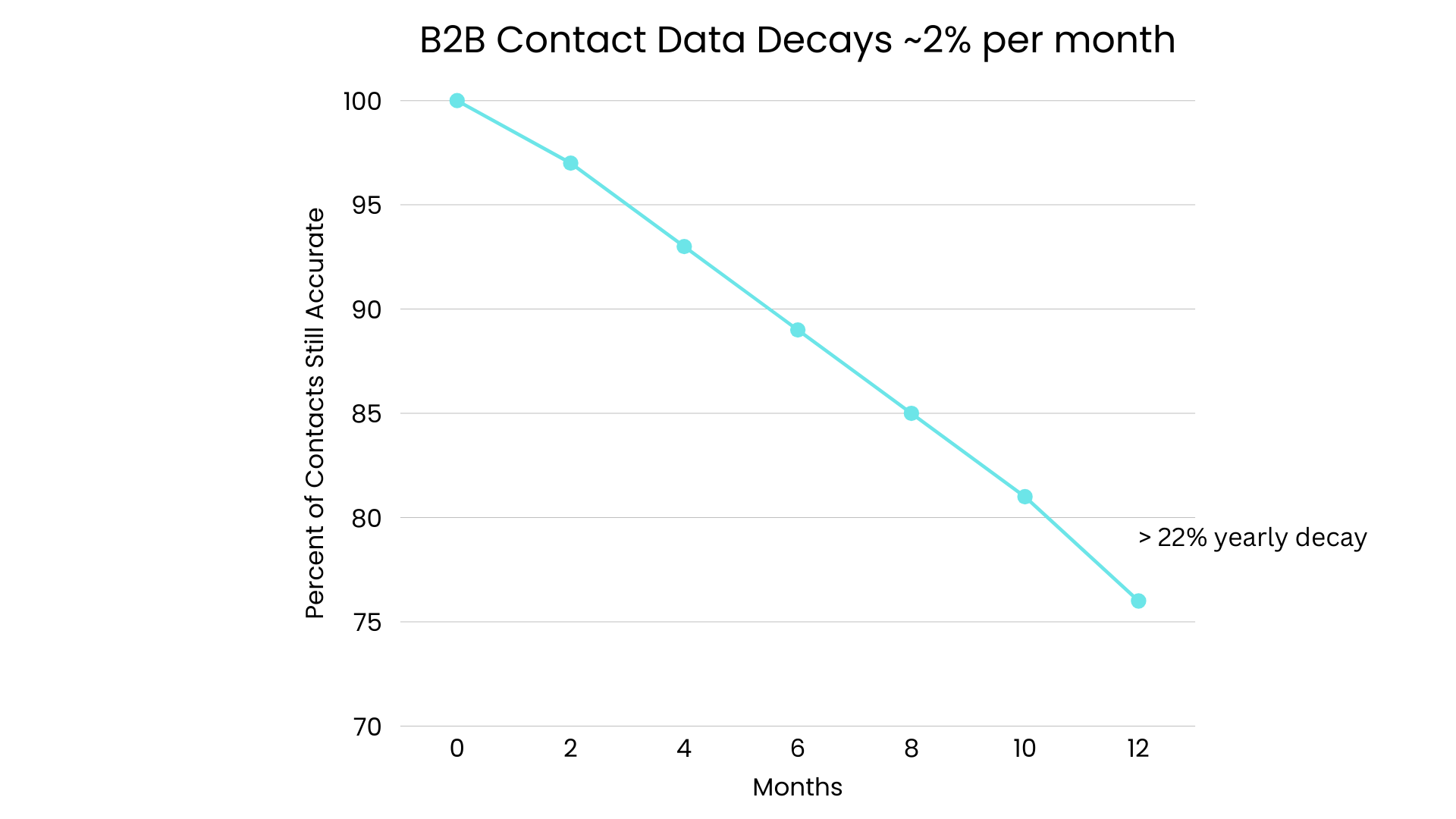Custom vs. Pre-Built Lead Lists (and Instant Lists): When to Use Each

When building B2B lead lists, you’ll usually choose between pre-built databases or custom lists. Each has pros and cons depending on whether you value speed, accuracy, or precision.
TL;DR
-
Pre-built lists are a good option when speed matters. They’re ready to use and help you fill the top of your funnel fast.
-
Custom lists take a bit more time, but they’re tailored specifically to what you need. You end up with leads that look a lot more like your ICP (Ideal Customer Profile). That usually makes conversations easier to start and improves your chances of actually landing in the inbox.
-
Instant Lists are kind of the best of both worlds. We refresh them every two weeks, so they stay current, and they're broad enough to give you a running start.
Some days, speed is everything. Other days, it’s all about precision. The key is knowing when to use what, and making sure you’re not hurting your deliverability in the process.
When Pre-Built Lead Databases Work and When They Don’t
With a pre-built platform, you can scan millions of records and pull what you need in minutes, which makes it handy for things like mapping out a market or testing messaging. The downside is that the data doesn’t always stay fresh. According to Ascentrik, most providers only update their databases on a set schedule (weekly, monthly, or even once a quarter). In between those updates, records start to go stale, and that’s usually when bounce rates rise.
Why Fresh B2B Contact Data Matters for Deliverability
B2B contact data gets old fast. On average, according to HubSpot, about 2% of it goes bad every month, which means more than a fifth of your list can be outdated in a year if you don’t refresh it. People change jobs, update their titles, move to new companies, or swap email domains. Companies merge, rebrand, or shut down. That’s why a list that worked great 6 months ago will not work as well now.
Bounced emails aren’t just frustrating, they’re a red flag for mailbox providers that your reputation might be dropping. Therefore verifying that the data stays fresh helps prevent your odds of hitting the inbox from shrinking.

Why Custom Lead Lists Deliver Higher Conversion Rates
Custom, human-verified lists, like the ones we build at Emarketnow, usually convert better because they’re built around your exact ICP and verified right before delivery. The result is outreach that lands with the people who actually own the problem you solve, not just people in similar roles who seem relevant on paper.
What you get is fewer dead ends, a cleaner CRM, and outreach that feels personal instead of like a cold blast.
And since the list is built just for you, you’re not competing with a dozen other teams sending the same pitch to the same people. You spend less time chasing dead ends and more time in real conversations that move deals forward.
What Are Emarketnow Instant Lists and How They Work
Sometimes you just need something fast and reliable. Instant Lists give you that; they’re pre-built, live for two weeks, then get replaced. Perfect if you’re after something broad and don’t want to stress about outdated data.
Instant Lists are kind of the middle ground: quicker than building something custom, but fresher than those stock databases that never change. It’s a simple way to stay fast and accurate.
| Type | What it is | Strengths | Trade-offs | Typical use |
|---|---|---|---|---|
| Pre-built database | A large, filterable data pool managed by a vendor | Fast, scalable, great for scouting | Higher bounce-rate risk; competitors can buy the same data | Market mapping, broad prospecting |
| Instant Lists | Broad pre-built segments we rotate every two weeks | Fast and fresh; simple categories | Less granular than custom; time-limited availability | Need-it-now coverage without stale data |
| Custom (human-verified) | Built to your ICP; verified right before delivery | Fresher, tighter ICP match; lower bounce risk; more unique | Generally higher per-contact cost; longer lead time | High-value campaigns where reply quality matters |
How To Choose and Combine Without Hurting Deliverability
-
Databases are great for exploring new segments, estimating your total addressable market, or testing messaging quickly. But keep in mind they usually update in batches. That means some of the data may already be aging when you get it.
-
Use Instant Lists when you need broad, ready-to-go coverage but still want some freshness built in. Thanks to the two-week rotation, you’re not pulling from a list that’s been sitting around for months.
-
Go with Custom Lists when precision really matters. They’re verified right before delivery and built around your exact ICP, so you’re reaching the right people with the right message.
-
And whatever you choose, keep your data clean. Re-verify older segments, suppress generic role-based emails, and keep a close eye on your bounce rate.
A Quick Vendor Checklist (Ask These Before You Buy)
-
Ask when the records were last updated. Was it this week, last month, or sometime last quarter? And more importantly, can they show proof?
-
Are they really verifying the email works, or just assuming based on formats like first.last@domain.com?
-
Do they offer any kind of guarantee or credit policy on bounce rates, or is there no safety net if a campaign underperforms?
At Emarketnow, every record is freshly verified before delivery, emails are genuinely validated for accuracy, and we provide a quality guarantee to protect customers in the rare event of higher-than-expected bounces.
Bottom line: Custom vs. Pre-Built vs. Instant Lists
Databases give you speed and coverage, but the data can go stale between updates. Instant Lists give you a quicker option without losing freshness. Because they’re only active for two weeks before being rotated out, they work well for broad categories like "Marketing Companies in the U.S."
Custom lists are made to fit your exact ICP. Since they’re checked right before you get them, the data’s fresher and you usually see better replies.
Whichever route you choose, keep in mind that contact data decays quickly, about 2.1% each month, which adds up to more than 22% a year. That’s why it’s so important to keep verifying and refreshing the data on a regular basis.
If you want to avoid dead ends in your next campaign, a custom list is the safest bet. When time’s tight, you can grab an Instant List for fast coverage without giving up on freshness.
FAQ
When should I use a pre-built database?
Use it when speed matters most. They’re great for market mapping, testing new messaging, or filling the very top of your funnel quickly. Just keep in mind the data can go stale between updates.
What makes custom lists worth the extra time?
Custom lists are built around your exact ICP and verified right before you get them. That means fewer bounces, fewer dead ends, and better conversations with people who actually care about what you offer.
How are Instant Lists different?
They’re refreshed every two weeks, so they stay current. Think of them as the middle ground: faster than custom, fresher than most databases, and perfect when you need coverage right now.
How do I choose the right type of list?
Databases are good for research, Instant Lists are fast and fresh, but custom lists usually win. They’re verified, built for your ICP, and deliver the best replies.
Ready to reach fresh, human-verified leads today?
Start for FreeRelated articles
How To Safely Blend First Party And Third Party B2B Data
Use your own first-party data to define your ICP, then fill the gaps with human-verified B2B contact lists. Learn how to merge both without disrupting your CRM.
Why Today’s Job Market Quickly Breaks Your CRM
See the key labor market stats behind job hopping and job hugging and learn why fast job changes cause your CRM to become outdated in under two years.
Scraped, Crowdsourced, and Research Grade B2B Data Explained
Most cheap B2B lists are scraped or pooled. See how to spot risky data, test any provider, and choose real research-grade human verified data.


